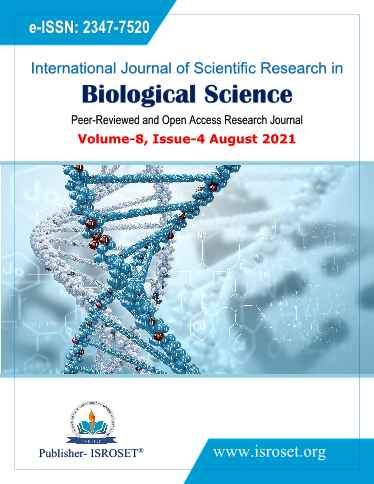Activity of Silver Nanoparticles Synthesized From Buttermilk Filtrate and Activity of Spices against Dental Cavity Causing Organisms
Keywords:
Buttermilk, Silver nanoparticles(AgNPs), streptococcus spp., UV-Vis spectroscopyAbstract
Bacterial oral pathogens can cause severe diseases with complications, severe soft tissue invasions, toxic syndromes and also cause infective endocarditis. This research paper provides comprehensive view on the silver nanoparticle synthesis from buttermilk filtrate, its characterization and its antimicrobial activity against dental pathogens. Also some spices was used to check their antimicrobial potential. The dental cavity causing organisms were isolated from patients having dental cavity problems. These organisms were identified as streptococcus spp. and candida spp. by performing morphological, cultural and biochemical characteristics referring to the bergey’s manual of determinative bacteriology. Silver nanoparticles were synthesized using buttermilk filtrate and characterization were done by UV-Vis spectroscopy and scanning electron microscopy. Extract of different spices as well as biologically synthesized silver nanoparticles were checked against identified clinical isolates by well diffusion method. Nanoparticles synthesized using buttermilk filtrate were more effective as compared to crude extracts against pathogenic strains of bacteria.
References
S. M. Abu Nayem, Narsin Sultana, Md. Aminal Haque, Billal Miah, Md. Mahmodul Hasan, Tamanna Islam, Md. Mahendi Hasan, Abdul Awal, Jamal Uddin, Md. Abdul Aziz and A.J. Saleh Ahammad, “Green synthesis of Gold and Silver Nanoparticles by using Amorphophallus paeoniifolius Tuber extract and Evaluation of their antibacterial activity”, MPDI Journals, vol 25., pp. 4773-4787, 2020
Xiung chen, Eric Banan- Mwine Daliri, Ramchandra Chelliah and Deog- Hwan Oh, “Isolation and identification of Potentially Pathogenic Microorganisms Associated with Dental Caries in Human Teeth Biofilms”, MDPI Journal, vol 8 pp112-116, 2020
Narayanswami Krithiga, Athimoolam Rajalakshmi, and Ayyavoo Jayachitra, Green synthesis of silver nanoparticles using Leaf Extracts of Clitoria ternatea and Solanum nigrum and study of its Antibacterial Effect against Common Nosocomial Pathogen, Journal of Nanoscience vol 10 pp. 1-8, 2015
Saba Pirtarighat, Maryam Ghannadnia and Saeid Baghshahi, “Green synthesis of silver nanoparticles using the plant extract of salvia spinosa grown in vitro and their antibacterial activity assessment”, Journal of Nanostructure in chemistry vol 9 pp 1-9, 2018
P Heera, S Shanmugam, “Nanoparticles synthesis characterization and applications”, International journal of current microbiology and applied sciences, vol 4, pp 379-386, 2015
Gericke, M.; Pinches, A. “Biological synthesis of metal nanoparticles. Journal of Hydrometallurgy”, vol 83,. Pp 132–140., 2006
Muhammad shobia, Iqra Muhammad, Zeeshan Ahmed Bhutta, Ishrat Yaseen, “A Mini Review on Commonly used Biochemical Tests for Identification of Bacteria”, International journal of Research Publications, vol 54, Issue-1 pp 1-9, 2020
Seema Rawat and Anurag Rawat, Antimicrobial activity of Indian spices against pathogenic bacteria, Advances in Applied science Research vol 6, Issue 3, pp 185-190, 2015
M Z H Khan, F K Tareq, M A Hossen, M N A M Roki, “Green synthesis and characterization of silver nanoparticles”, Journal of Engineering science and technology vol. 13, Issue 1., pp.158-166, 2018
Peter Logeswari, Sivagnanam Silambarasan, Jayanthi Abraham, “Synthesis of silver nanoparticles using plant extract and analysis of their antimicrobial property”, Journal of Saudi chemical society, vol 19 Issue 3, pp 311-317, 2015
Kumar K. P. Paul, W. Sharma, C.P., “Green synthesis of gold nanoparticles with Zingiber officinale extracts: characterization and blood compatibility. Process. Biochem” vol 46 pp 805-810, 2011
Saad Haroon Anwar, “Nanoparticles-Types types of platforms, Biological Synthesis and application. Journal of material sciences”, vol. 6 Issue 2 pp 1-9, 2018
Senapati, S, Ahmad, A, Khan, M.I, Sastry, M, Kumar, R “Extracellular biosynthesis of bimetallic Au-Ag alloy nanoparticles”, Pubmed, vol 1, Issue 5 pp 517–520. 2005
Xian chen, Eric Banan- Mwine Dalliri, Ramchandran chellen and Deog- Hwan Oh, “Isolation and identification of Potentially Pathogenic Microorganisms Associated with dental caries in Human teeth biofiulms”, MDPI Journals, vol 8 Issue 10 pp 1-12, 2020
Sura. I A, Raflaa S H, Zahraa Altaee, Hawraa M R, “Isolation and identification of bacteria and parasite from teeth caries and poeridontal”, Journal of advances in Environmental biology, vol 9 Issue 22 pp 50-53, 2015
Shantkriti S, Rani P, “Biological synthesis of copper nanoparticles using Pseudomonas fluorescens” International Journal of Current Microbiology and Applied Sciences vol. 3 Issue 9 pp 374–383, 2014
Kalishwaralal K, Deepak V, Pandian SRK, Gurunathan S, “Biological synthesis of gold nanocubes from Bacillus licheniformis”. Bioresource Technology vol. 100 Issue 21 pp 5356–5358, 2009
Yates MD, Cusick RD, Logan BE, “Extracellular palladium nanoparticle production using Geobacter sulfurreducens.” ACS Sustainable Chemical Engineering vol. 1 Issue 9 pp 1165–1171, 2013
Jha A K, Prasad K, Kulkarni A, “Synthesis of TiO2 nanoparticles using microorganisms. Colloids and Surfaces B: Biointerfaces”, vol 71 Issue 2 pp 226–229, 2009
N. Muruganantham, R. Govindharaju, P. Anitha, V. Anusuya, “Synthesis and characterization of silver nanoparticles using Lablab purpureus flowers (Purple colour) and its- antimicrobial activities”, International journal of scientific research in biological sciences, Vol. 5, Issue. 6., pp. 1-7, 2018
Prabhu and Ediho K Paulose, “Silver Nanoparticles: mechanism of action, Synthesis, medical applications and toxicity effects”, International journal of nano letters vol 6 Issue 1 pp 120-135, 2016
Vincent Ki MD, Coleman Rotstein MD FRCPC, “Bacterial skin and soft tissue infection in adults: A review of their epidemiology, pathogenesis, diagnosis, treatment and site of care”, Can J Infect Dis Med Microbiol vol 19 Issue 2, pp 173-184, 2008
Downloads
Published
How to Cite
Issue
Section
License

This work is licensed under a Creative Commons Attribution 4.0 International License.
Authors contributing to this journal agree to publish their articles under the Creative Commons Attribution 4.0 International License, allowing third parties to share their work (copy, distribute, transmit) and to adapt it, under the condition that the authors are given credit and that in the event of reuse or distribution, the terms of this license are made clear.







